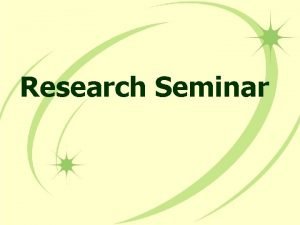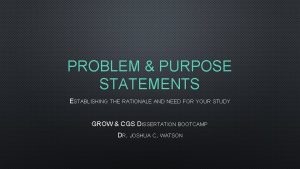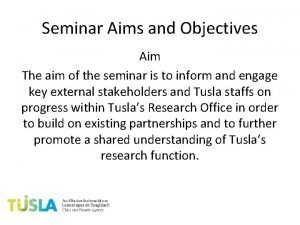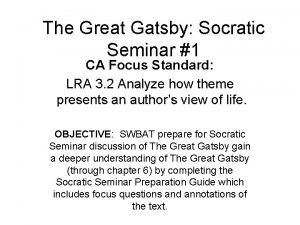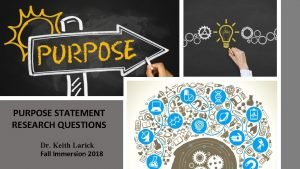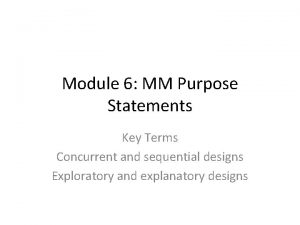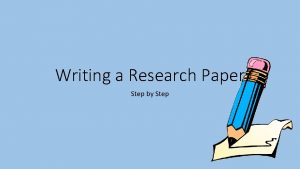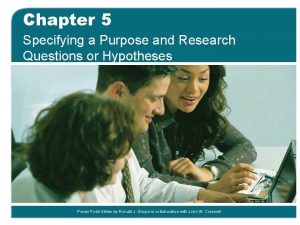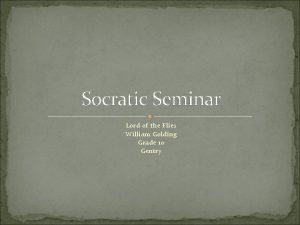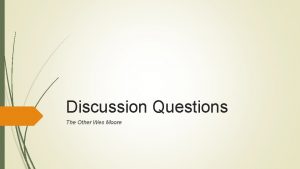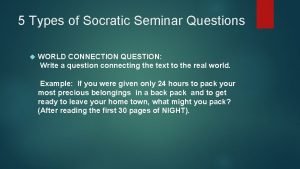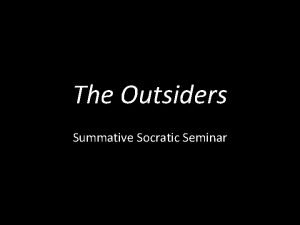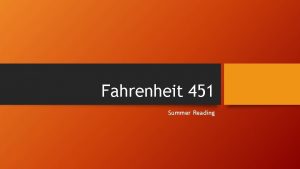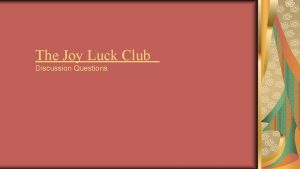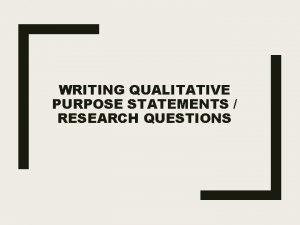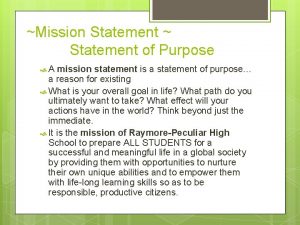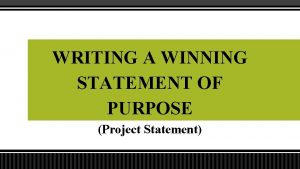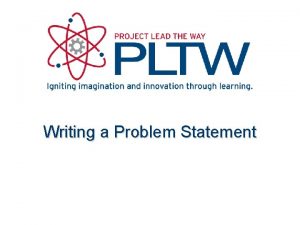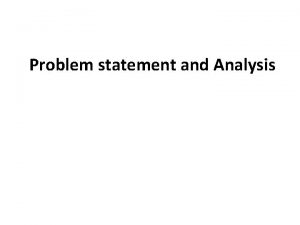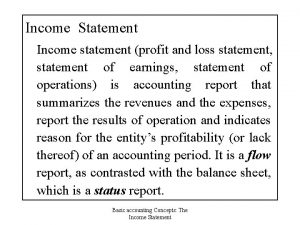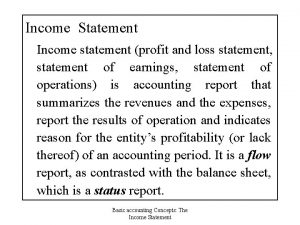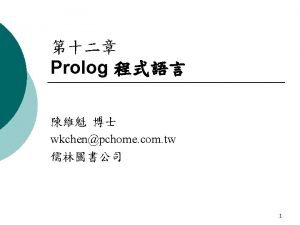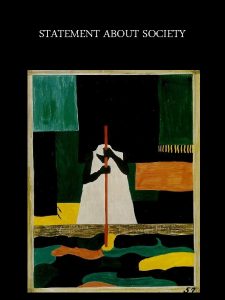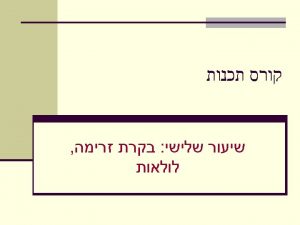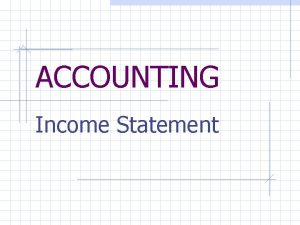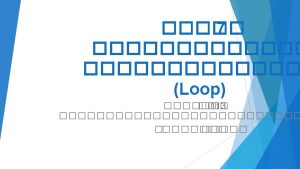Research Seminar Writing purpose statement and research questions



















- Slides: 19

Research Seminar

Writing purpose statement and research questions To write quantitative purpose statements, • research questions, and hypotheses, you need to understand the importance and use of • variables.

Specify Variables v A variable is a characteristic or attribute of an individual or an organization that (a) researchers can measure or observe and (b) varies among individuals or organizations v studied. They are key ideas that researchers seek to collect information on to address the purpose of their study.

Dependent Variables v A dependent variable is an attribute or characteristic that is dependent on or influenced by the independent variable. You may find them labeled in the literature as the outcome, effect, criterion, or consequence variables. v Researchers typically investigate multiple dependent variables in a single study , although in many studies, one of the dependent variables is typically of central interest. Dependent variables can be measured using continuous or categorical scores.

Independent Variables v An independent variable is an attribute or characteristic that influences or affects an outcome or dependent variable.

Writing Quantitative Purpose Statements quantitative purpose statement identifies the variables, their relationship, and then participants and site for research. Several guidelines can help you prepare good purpose statements: v Write the purpose statement in a single sentence. v Begin the statement with key identifier words, such as “The purpose of this study, ” to clearly signal readers. v If you plan to use a theory, introduce it in this statement by stating that you plan to “test a theory. ” v Three options exist for using variables in this statement: You seek to relate two or more variables, to compare a variable composed of two or more groups in terms of the dependent variable, or to describe one variable. Use the words relate or compare or describe to indicate whether variables will be related, groups will be compared, or variables will be described.

v If variables are related or groups compared, specify the independent and dependent variables and any control or intervening variables. v State the independent variable first (first position in the sentence), followed by the dependent variable (second position in the sentence). If control or mediating variables are used, state them last (in the third position in the sentence). The placement of these variables in this sentence is important because quantitative researchers often view variables as related from left to right. v Identify the participants to be studied and the research site at which they will be studied.

Writing Quantitative Research Questions v Because research questions narrow and focus the purpose statement, they serve to restate the purpose in specific questions that the researcher seeks to answer. Research questions describe the participants’ reactions to a single variable, compare groups on an outcome, or relate to variables. Research questions are found in all designs in quantitative research, such as in experiments, correlational studies, and surveys.

Guidelines The basic steps in forming a research question are: v Pose a question v Begin with “how, ” “what, ” or “why” v ◆Specify the independent, and mediating or control variables v Use the words describe, compare, or relate to indicate the action or connection among the variables v Indicate the participants and the research site for the study

Plagiarism and self-plagiarism

v. Plagiarism is unauthorized appropriation of other people’s ideas, processes or text without giving correct credit and with intention to present it as own property. Appropriation of own published ideas or text and passing it as original is denominated self-plagiarism and considered as bad as plagiarism.

v The frequency of plagiarism is increasing and development of information and communication technologies facilitates it, but simultaneously, thanks to the same technology, plagiarism detection software is Developing. v Within academia, plagiarism by students, professors, or researchers is considered academic dishonesty or academic fraud, and off enders are punished by sanctions ranging from suspension to termination, along with the loss of credibility and perceived integrity.

v self- Plagiarism is commonly described as recycling or reusing one’s own specific words from previously published texts. While it doesn’t cross the line of true theft of others’ ideas, it nonetheless can create issues in the scholarly publishing world. v Self-plagiarism can also refer to the publication of identical papers in two places (sometimes called “duplicate publication”). v Moreover, it is best practice to cite your previous work thoroughly, even if you are simply revisiting an old idea or a previously published observation.

v Self-plagiarism involves dishonesty but not intellectual theft. Roig (2004) offers a useful classification system including four types of self-plagiarism: v duplicate publication of an article in more than one journal; v partitioning of one study into multiple publications, often called salami-slicing; v - text recycling; and v copyright infringement.

v. In short, self-plagiarism is any attempt to take any of your own previously published text, papers, or research results and make it appear brand new

How to avoid plagiarism

v Plagiarism can be a confusing and overwhelming topic. To learn more about plagiarism and how to avoid it, complete each of the steps below. Step 1: Understand Plagiarism v Plagiarism is when you use another person’s words or ideas and try to pass them off as your own. However, plagiarism can take many different forms. Step 2: Properly Quote and Paraphrase v Using outside evidence is important in academic writing, but those sources must be used appropriately. You can include information from outside sources through proper paraphrasing and quoting

Step 3: Properly Cite Sources v As noted in Step 2, you can paraphrase and quote pieces of evidence to include information from outside sources. But, all of that information must be cited within your paper using in-text citations and a separate references list. Step 4: Check Your Work for Possible Plagiarism

 Research purpose example
Research purpose example Rationale and problem statement
Rationale and problem statement The seminar aims at
The seminar aims at The great gatsby socratic seminar questions and answers
The great gatsby socratic seminar questions and answers Purpose of the study example
Purpose of the study example Research purpose statement examples
Research purpose statement examples Purpose statement in research example
Purpose statement in research example Thesis statement example
Thesis statement example Specifying the purpose of research
Specifying the purpose of research Socratic seminar questions for night
Socratic seminar questions for night Socratic seminar questions for lord of the flies
Socratic seminar questions for lord of the flies The other wes moore socratic seminar questions
The other wes moore socratic seminar questions Socratic seminar questions for the glass castle
Socratic seminar questions for the glass castle Socratic seminar question examples
Socratic seminar question examples The outsiders socratic seminar questions
The outsiders socratic seminar questions The crucible act 3 discussion questions
The crucible act 3 discussion questions Hamlet socratic seminar questions
Hamlet socratic seminar questions Fahrenheit 451 socratic seminar questions
Fahrenheit 451 socratic seminar questions Claymore
Claymore Scar the joy luck club
Scar the joy luck club
